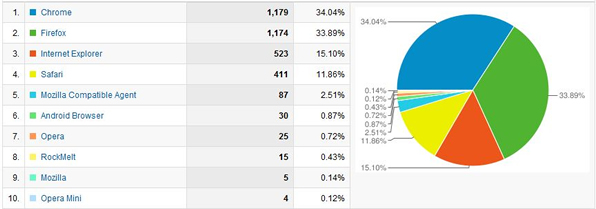

Regardless of where you are in the development of your business Web presence you are probably considering a website redesign, or at least you should be. Why? Because Web and mobile technology are advancing so fast that your current site is probably already obsolete in terms of performance and business ROI. Where does that leave you? Do you need to spend thousands of dollars every year to stay current? Or is there a strategy that can minimize ongoing costs and "futureproof" your site? In this series of posts, I will talk about the top three things you need to work out with your web design company to make that happen. Today's post - the browser wars.

As I'm sure you're aware by now, your website was not created equal across all desktop website browsers (we'll deal with mobile in my next post) and screen resolutions. Even though the current version of Internet Explorer is IE9, there are still large numbers of users on IE8, IE7 and even IE6. Going forward, you can expect new versions of IE more-or-less yearly through 2020. While IE9 is getting close to Web standards compliance (delivering a consistent look-and-feel for all web sites that adhere to coding standards), it's only available on Windows 7 machines, while IE8 is still the latest version on XP. The older versions (including IE8) still have different, and often ugly, ways of displaying HTML and CSS, which means your website looks "broken" in one or more ways. The good news? Microsoft has recently announced that it will automatically update IE users to the latest version though its Windows Update service. We'll see how well that works. There will be a lot of screaming from users still clinging to legacy intranets and other web programs designed for the old browsers.
Firefox has done a bit better with Web standards compliance, although while the latest versions FF6 and FF7 work well with most modern designs, older versions FF3.5 and FF4 commonly break much like IE6-8. The only major browser that appears to have solved the problem is Chrome, which automatically updates your browser to new versions without asking your permission. Unlike IE or FF, the update is pretty much invisible and fast so it doesn't impose an unnecessary hassle on the user. Bottom line, the 3 major browsers haven't yet converged on a common way of displaying websites, so designers and developers still struggle with making your website look good across all of the browsers and their multiple versions still in use.
To make matters even more complicated, a new set of Web standards, HTML5 and CSS3, will be released in the not-too-distant future. The new standard will promote faster response for browsing, especially graphics and multimedia, but will require major updates by the browser vendors to support it. If you are a designer/developer and you aren't studying up on these coming changes, you would be well served to get off your rear end.
Unfortunately, we're still in browser design-testing mode, which means that you throw a design up on the web and test it in all of the browsers, then tweak to fix. From my experience, this probably adds over 30% to the ultimate time and cost for designing a website. What else could we do?
So that's where we are for now - still mired in a time-wasting, costly exercise of building websites that tend to be obsolete within a few years. Granted, it's very difficult for any company, especially the website design firms, to stay current and committed to "futureproofing" websites. I vow to take a tougher stand on this issue in 2012. In my next post, I will discuss our next great website challenge - going mobile. Please stay tuned.
Learn how to design and set up your website for maximum brand exposure and lead conversion. This is insider information normally reserved for our inbound marketing and web design clients.
| Follow @jmctigue |
| Follow @Kuno |